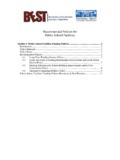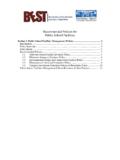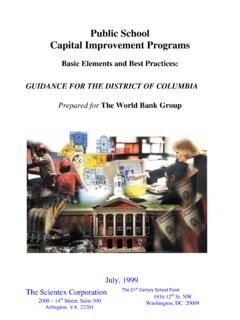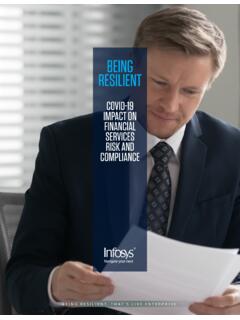Transcription of Research on the Impact of School Facilities on Students ...
1 Research on the Impact of School Facilities on Students and Teachers A Summary of Studies Published Since 2000 Study TitleResults Independent VariableIndependent Variable Data SourceDependent Variable Sample Blincoe, J. M. (2008). The age and condition of Texas high schools as related to student academic achievement. ( , University of Texas at Austin).4-9% difference between Students in schools in worst/best condition ; 5-9% difference between Students in oldest/newest schools; 4% difference in graduation rates between Students in schools in worst/best condition and between Students in oldest/newest schoolsSchool condition rating, School ageAdministrative dataTest scores (science/math/english)Texas high schools (n=416)Boese, S., & Shaw, J. (2005). New York state School Facilities and student health, achievement and attendance: A data analysis report. Healthy Schools Network. higher suspension rates (2-9%), lower attendance rates in middle and high School (2-3%), lower test scores (~5%) Number of unsatisfactory building systems (0 vs.)
2 1+)Administrative dataTest scores, attendance & suspension ratesSchools in New York's Duschess & Columbia counties (n=23)Branham, D. (2004). The wise man builds his house upon the rock: The effects of inadequate School building infrastructure on student attendance. Social Science Quarterly. The quality of School infrastructure has a significant effect on School attendance and drop-out rates. Students are less likely to attend schools in need of structural repair, schools that use temporary structures, and schools that have understaffed janitorial condition (in need of repair), % temporary space, custodians/sq ft, & sq ft/studentAdministrative dataStudent attendance and drop-out ratesSchools in Houston, TX (n=226)Buckley, J., Schneider, M., & Shang, Y. (2004). Los Angeles unified School district School Facilities and academic performance. Washington, DC: National Clearinghouse for Educational Facilities .
3 Changing from worst to best Overall Environmental Compliance Rating leads on average to a 36 point increase in a School 's API. Facility overall environmental compliance rating Administrative dataTest scores (CA API)Schools in the LA Unified School District (n=509)Buckley, J., Schneider, M., & Shang, Y. (2005). Fix it & they might stay: School facility quality and teacher retention in Washington, Teachers College Press, 107, 1107-1123. Approximately 5% more teachers likely to stay in a building in "A" condition vs. "F" conditionFacility condition gradeTeacher surveysTeacher retention in coming yearK-12 Teachers in the DC Public Schools (n=835)Bullock, C. C. (2007). The relationship between School building conditions and student achievement at the middle School level in the commonwealth of Virginia. ( , Virginia Polytechnic Institute and State University). Percentage of Students passing SOLs was higher in English, mathematics and science in standard buildings than it was in substandard buildingsSchool condition ratingCommonwealth Assessment of Physical Environment assessment completed by School principalsTest scores (percent passing middle School SOL exam)Virginia middle schools (n=111)Cellini, S.
4 R., Ferreira, F. V., & Rothstein, J. (2008). The value of School Facilities : Evidence from a dynamic regression discontinuity design (#14516 ed.). Washington, DC: National Bureau of Economic results - inconclusive or small positive results in early years, trending up to a peak of 1/6th of a School -level standard deviation six years after bond passage. (however point estimates fall back to zero after).Passage of a capital bond by the School district Administrative dataTest scores (various CA tests at a range of grade levels)California School districts (variable sample by type of analysis, maximum n=948)Chaney & Lewis (2007) Public School principals report on their School Facilities . Washington, DC: National Center for Education Statistics, Institute of Education one-third of schools indicated that there was at least one factor that interfered with their ability to deliver instruction to at least a moderate extent (32 percent with regard to permanent buildings, and 35 percent with regard to portable buildings).
5 Across the 9 factors, 6-16% of schools reported that each factor interfered with condition rating & condition of individual systemsPrincipal assessmentsImpact of Facilities on instructionNational sample of public School principals (n=1085)Crampton, F. E. (2009). Spending on School infrastructure: Does money matter? Journal of Educational Administration, 47(3), 305-322. Results would predict an increase in NAEP scores of .236 points per additional dollar/pupil invested in infrastructure (based on a .236 structural coefficient across three years of NAEP scores). Total annual state K-12 capital outlayAdministrative dataTest scores (NAEP state averages)US states (n=50)Duran-Narucki, V. (2008). School building condition, School attendance, and academic achievement in New York City public schools: A mediation model. Journal of Environmental Psychology, 28, schools with poor Facilities , Students attended less days on average and therefore had lower grades in ELA and Math standardized tests.
6 Attendance was found to be a full mediator for grades in ELA and a partial mediator for grades in building condition indexAdministrative dataTest scores and attendanceElementary schools in New York City (n=95)Earthman, G. I., & Lemasters, L. K. (2009). teacher attitudes about classroom conditions . Journal of Educational Administration, 47(3), in schools in satisfactory conditions are significantly more likely to express positive attitudes about their classrooms than teachers in unsatisfactory buildings (across a wide range of indicators, but limited sample prevents causal inferences).Classroom condition ratingsTeacher surveysTeacher attitudesVirginia teachers (n=165)Hughes, S. M. (2006). The relationship between School design variables and student achievement in a large urban Texas School district. ( , Baylor University).Many positive correlations between building design variables and student achievement were reportedEleven design variablesResearcher-completed assessment using the Design Assessment Scale for Elementary SchoolsTest scores (reading, math & writing)Schools in a large urban Texas School district (n=20)Kumar, O'Malley & Johnston (2008) Association between physical environment of secondary schools and student problem behavior - A national study, 2000-2003.
7 " Environment and Behavior, 40(4): based on multilevel logistic and linear regressions indicate that Students are sensitive to schools' ambience and that the association of various aspects of the School 's physical environment with Students ' problem behaviors is positive for all Students and greater for 10th-grade Students than for 8th- and 12th-grade Students . School environment/ ambienceStudent & principal surveysTruancy, cigarette, alcohol, and marijuana useNational sample of 8th, 10th & 12th grade Students plus School principals (n=70,884 Students plus one principal/ School in 655 schools)Lewis, M. (2000). Where children learn: Facility condition and student test performance in Milwaukee public schools. Scottsdale, AZ: Council of Educational Facility Planners. Significant relationships for facility measures explained 10-15% of the differences in student test scores across schools after controlling for student condition rating & facility educational adequacy scoreAdministrative dataTest scores (WSAS reading & math)K-12 schools in Milwaukee Public Schools (n=139)Picus, L.
8 O., Marion, S. F., Calvo, N., & Glenn, W. J. (2005). Understanding the relationship between student achievement and the quality of educational Facilities : Evidence from Wyoming. Peabody Journal of Education, 80(3), 71-95. No discernable relationship between test scores and building condition scoresBuilding quality scoreAdministrative dataTest scores (reading, math & writing)Wyoming public schools (n=296)Plank, S., Bradshaw, C., & Young, H. (2009). An application of broken windows and related theories to the study of disorder, fear, and collective efficacy in schools. American Journal of Education, 115(2), analyses reveal a direct association between physical disorder and social disorder even when prior levels of collective efficacy are controlled. Further, there is evidence that the effects of physical disorder may be operating through increased fear and decreased collective efficacy to affect perceptions of disorder measuresStudent surveysMeasures of social disorder and collective efficacySchools serving 6-8 graders in a large mid-Atlantic urban School district (n=33)Schneider, M.
9 (2003) Linking School Facility conditions to teacher Satisfaction and Success. Washington, DC: National Clearinghouse for Educational Facilities affect the health and productivity (attendance) of teachers and make retention of teachers difficult (especially for schools with a condition grade of C or less). On the academic side, a shift from the best Facilities to the worst decreases student test performance by ~3% (in DC this is for both math and reading, in Chicago for % of Students performing at/above grade level). School facility design & condition gradesTeacher surveysTest scores and teacher health, attendance, and retentionTeachers in Chicago, IL & Washington, DC (n=688 & 1273 respectively)Sheets, M. E. (2009). The relationship between the condition of School Facilities and certain educational outcomes, particularly in rural public high schools in Texas. ( , Texas Tech University).
10 The condition of School Facilities has a measurable effect over and above socioeconomic conditions on student achievement and teacher experience/turnover. Most significantly, for every 10% reduction in the percent of portable facility sf/student, test scores increased by 11 points and for every 10% increase in deferred maintenance, average test scores decreased by measures of facility conditionAdministrative dataTest scores, attendance & teacher experience/turnoverRural Texas high schools (n=72)Stevenson, K. R. (2001). The relationship of School Facilities conditions to selected student academic outcomes: A study of South Carolina public schools. SC Education Oversight is a significant relationship between building condition and test scores. Additionally, at least 75% of principals indicated that the adequacy of the School facility impacted teacher attitudes, teacher recruitment and retention, student behavior, and parent and community attitudes and support.







